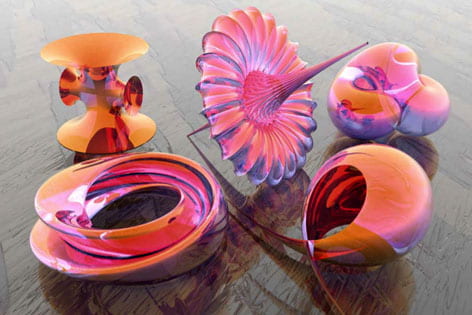The art of math
They look fragile and ornate, like glass vases on a tabletop. But the five objects in this still life are not real; they are computer-generated images of mathematical equations. They are giving mathematicians a powerful new way to visualize ideas and concepts, and showing the general public that math can be, well, breathtaking.

They look fragile and ornate, like glass vases on a tabletop. But the five objects in this still life are not real; they are computer-generated images of mathematical equations. They are giving mathematicians a powerful new way to visualize ideas and concepts, and showing the general public that math can be, well, breathtaking.
“For some reason, mathematical objects created purely for scientific purposes often turn out to be beautiful,” says Richard Palais, UC Irvine mathematics adjunct professor, who developed the software used by graphic artist Luc Benard to create the rendering.
The five-object image has caught the attention of top science editors and artists. In 2006, it placed first in the illustration category of the Science and Engineering Visualization Challenge sponsored by the National Science Foundation and Science magazine and ran on the cover of the magazine. Last year, it was featured in a German mathematical art exhibition, where it received rave reviews from organizers and guests.
Palais and Benard began working together about four years ago when Benard learned to use Palais’ program, 3D-XplorMath. The software turns mathematical equations into data that can be visually expressed on a computer screen.
Benard created the five objects with 3D-ExplorMath, then used another graphics program to give them the look of blown glass and arrange them in the still life.
“When I first saw them, they looked so physically real I thought Luc must have somehow found a way to recreate them out of actual blown glass,” Palais says.
He developed his program to help mathematicians “see” equations with high precision. Mathematicians also use it as a teaching tool.
Palais’ first attempt at mathematical visualization was at the request of his wife, UCI mathematics professor Chuu-Lian Terng, who – as part of her research – needed to see what a particular surface looked like. (It is the top-middle object in the image.)
Says Palais: “I eventually became so impressed by what artists were able to do with my program that today its aesthetic use is of equal importance and interest to me as its scientific use.”